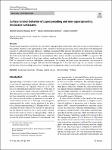Tìm kiếm
Tác giả
- C., Oniciuc (1)
- Joachim, Venzmer (1)
- Nadira, Saab (1)
- S., Montaldo (1)
- Sau >
Chủ đề
Năm xuất bản
Toàn văn
- true (3)
Kết quả tìm kiếm
Technology creates variant learning experiences which are context specific. This study examined the comparative potential of multimodal and text-based Computer Mediated Communication (CMC) in fostering learner autonomy, learner engagement and learner e-satisfaction as well as learner writing quality. To this end, 40 Iranian male and female EFL (English as foreign language) students were selected on the basis of their writing proficiency and were randomly assigned into text-based and multimodal CMC research groups. Learner autonomy was investigated using Van Nguyen and Habók ‘s learner autonomy questionnaire, which had 40 items rated on 5 point likert scale, both before and after the treatment. Student engagement was tracked by analyzing transcription of stored conversations of Moodl... |
In this paper, we shall assume that the ambient manifold is a pseudo-Riemannian space form Nm+1t(c)
of dimension m+1 and index t (m≥2 and 1≤t≤m). We shall study hypersurfaces Mmt′ which are polyharmonic of order r (briefly, r-harmonic), where r≥3 and either t′=t or t′=t−1. Let A denote the shape operator of Mmt′. Under the assumptions that Mmt′ is CMC and TrA2 is a constant, we shall obtain the general condition which determines that Mmt′ is r-harmonic. |
One parameter frequently considered to be relevant for superspreading of trisiloxane surfactants is surface tension kinetics. In the scientific literature, some experimental results reported for trisiloxane surfactants are in contradiction with fundamental concepts of surfactant monomer diffusion. Therefore, maximum bubble pressure tensiometry has been used to determine dynamic surface tension (DST) of two types of trisiloxane surfactants: superspreader and non-superspreader. Results show that both surfactants behave similarly at concentrations below critical micelle concentration (CMC), as expected. The CMC curves, as determined by drop shape analysis, confirmed that the more hydrophilic non-superspreader has a higher CMC as compared to the more hydrophobic superspreader. |



